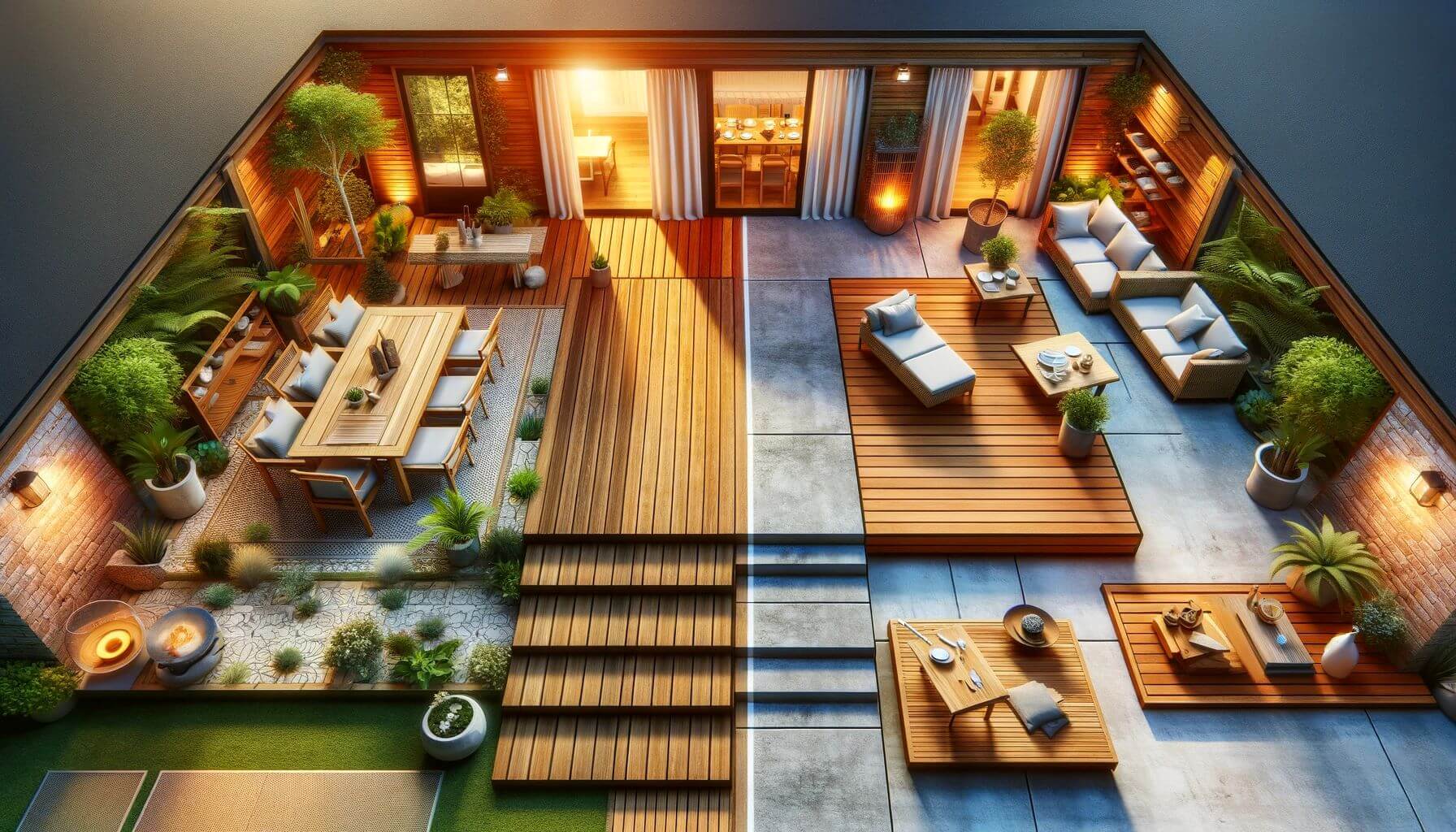
At the heart of crafting the perfect outdoor sanctuary lies a pivotal decision every homeowner must face: the choice between a wood deck and a concrete patio. This juncture presents not just a question of material preference but a deeper deliberation on lifestyle, aesthetics, and functionality that will define the outdoor living space for years to come.
The essence of this article is to illuminate the paths leading to either option, wood decks with their natural allure and warmth, and concrete patios, champions of sleek design and modernity. Through a detailed exploration, we aim to compare and contrast these popular choices, shedding light on the nuances of each to empower you, the homeowner, with the insights necessary for a decision that aligns with your vision of outdoor living.
We will explore the realms of aesthetics, installation, durability, and beyond, guiding you to a choice that not only enhances your home but also enriches your outdoor lifestyle.
Key Factors to Consider between Wood Deck vs Concrete Patio
Aesthetics and Design Flexibility
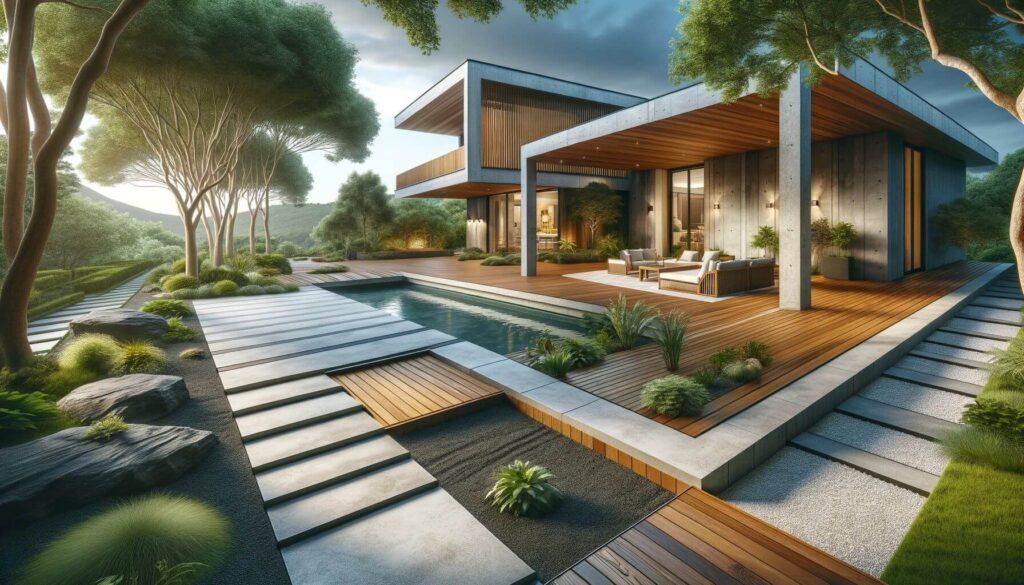
When envisioning your outdoor oasis, the material you choose lays the foundation for its ambiance and style. Here, we will go into the distinctive aesthetics of wood decks vs concrete patios, alongside their design flexibility.
Warm Embrace of Wood Decks vs Concrete Patio
Wood decks are synonymous with natural beauty and warmth, offering a timeless charm that effortlessly complements any landscape. The rich textures and varied color palettes of wood, from the honeyed tones of pine to the deep hues of walnut, bring a sense of organic elegance to your outdoor space.
Beyond aesthetics, wood decks boast remarkable design versatility, allowing for an array of styles, from classic to contemporary. Whether it’s the rustic appeal of a traditional deck or the sleek lines of a modern design, wood’s adaptability ensures it can be tailored to embody your unique vision.
Sleek Modernity of Concrete Patios vs Wood Decks

In contrast, concrete patios offer a canvas for sleek, modern design. Renowned for its clean lines and smooth finishes, concrete delivers an undeniably contemporary appeal that pairs well with minimalist landscapes and avant-garde homes. But don’t mistake its simplicity for monotony; concrete is a chameleon in the design world.
Through staining, stamping, and other texturing techniques, it can mimic other materials or take on vibrant colors, unlocking a spectrum of customization options. From the understated elegance of a gray, polished surface to the bold statement of a stamped pattern that emulates natural stone, concrete patios redefine flexibility in outdoor design.
Tale of Two Textures: Concrete Patio vs Wood Deck
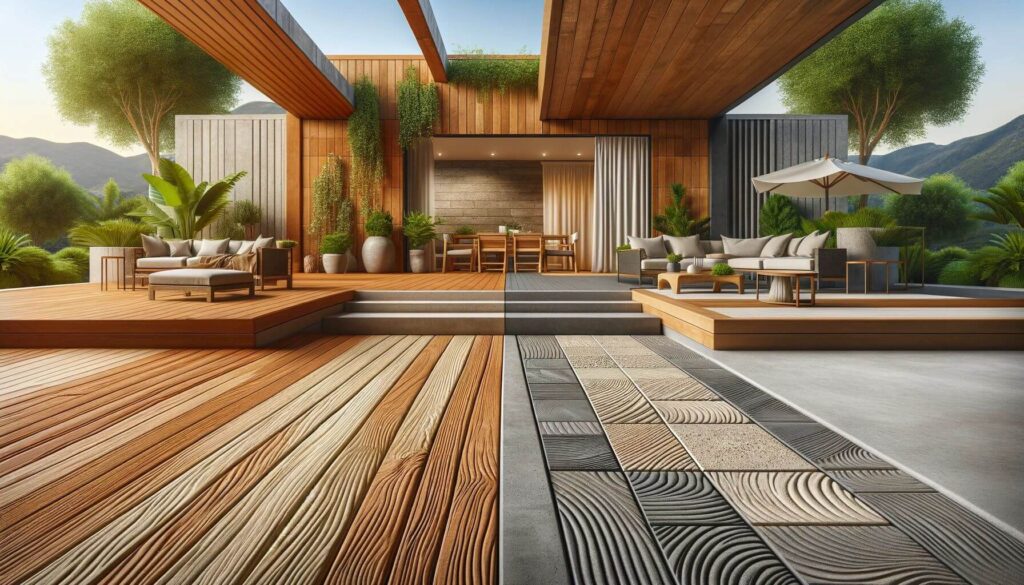
Both wood decks and concrete patios offer distinct textures that can significantly impact the overall feel of your outdoor area. Wood’s natural grain provides a tactile experience underfoot, inviting barefoot strolls during warm summer evenings. Meanwhile, concrete’s smoothness lends itself to a more urban, clean aesthetic, appealing to those who favor a more refined outdoor environment.
Embracing Design Versatility: Deck or Concrete Patio

Ultimately, the choice between wood and concrete doesn’t rest solely on their innate characteristics but also on their ability to adapt to your design aspirations.
Whether you’re drawn to the organic allure of wood or the minimalist chic of concrete, both materials offer a breadth of customization options that can transform your outdoor space into a reflection of your personal style and needs.
Installation of Wood Deck vs Concrete Patio
To enhance your outdoor living space brings you to a crucial consideration: the installation process and the initial costs associated with wood decks and concrete patios. Each option comes with its unique set of complexities and cost factors, influencing your decision based on budget, timeline, and desired outcome.
Wood Decks: A Craft of Carpentry
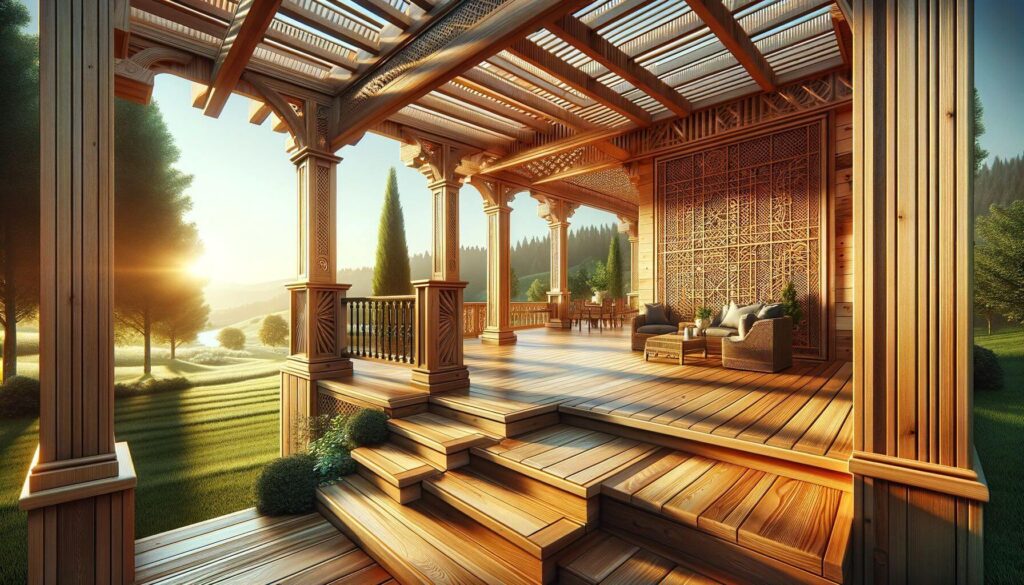
The installation of a wood deck is a nuanced process that demands skilled craftsmanship. It begins with the construction of a support framework, typically made of pressure-treated lumber, ensuring the deck’s stability and longevity.
The choice of wood, from cost-effective pine to premium exotic hardwoods, significantly affects both the aesthetic appeal and the price point. Installation complexity can vary based on design intricacies, elevation, and added features like railings or steps.
On average, wooden decks present a moderate to high initial investment, influenced by the quality of materials and the labor intensity of the build. The allure of wood, however, lies in its ability to offer a high return on investment through increased property value and aesthetic charm.
Concrete Patios: The Solid Groundwork
In contrast, the installation of a concrete patio is marked by its straightforwardness and efficiency. The process typically involves preparing the ground, creating forms, pouring the concrete, and then finishing it with the chosen texture or pattern.
Concrete’s cost-effectiveness is one of its most appealing attributes, offering a durable outdoor solution without the high price tag associated with premium wood or intricate deck designs. However, the overall cost can vary depending on factors such as the patio’s size, the complexity of the desired finishes, and accessibility to the site. Concrete patios require less labor compared to wood decks, making them a more budget-friendly option for those seeking a simple yet stylish outdoor space.
Wood Deck vs Concrete Patio Cost
Several factors influence the pricing of both wooden deck and concrete patios, including:
- Material Quality: Higher-quality woods and specialized concrete finishes can increase the project’s cost.
- Design Complexity: Custom designs, intricate patterns, and additional features like built-in seating or fire pits can add to the expense.
- Labor: The skill level and labor hours required for installation directly impact the overall cost.
- Location: Regional pricing variations and accessibility of the installation site can also affect the final price.
Making an Informed Decision Concrete vs Wood Deck
When comparing wood decks and concrete patios, it’s essential to consider not just the initial installation cost but also the long-term value and enjoyment they bring to your home. While wood decks may require a higher upfront investment, they offer warmth and natural beauty.
Concrete patios, on the other hand, provide a cost-effective, durable option with considerable design flexibility. Your choice will ultimately reflect your personal preferences, lifestyle, and how you envision your outdoor living space.
Wooden Deck vs Concrete Patio: Durability and Maintenance:
Creating an inviting outdoor living space requires not only an initial investment but also a commitment to ongoing maintenance to ensure its longevity. The durability of wood decks and concrete patios under varying weather conditions, along with their respective maintenance requirements, plays a crucial role in their long-term appeal and functionality.
Wood Decks: Embracing Nature with Care
Wood decks, celebrated for their natural beauty, demand attention to withstand the test of time and weather. The longevity of a wood deck is significantly influenced by the type of wood used, with options ranging from pressure-treated lumber, known for its resistance to decay and insects, to exotic hardwoods that offer superior durability and resistance to weathering. Regardless of the wood type, decks are susceptible to weather-induced wear, including sun damage, moisture-related rot, and warping.
Maintenance Essentials for Wood Decks:
- Regular Cleaning: Keep the deck clean from debris and dirt to prevent mildew and mold growth.
- Sealing and Staining: Applying a water-repellent sealant or stain every two to three years protects the wood from moisture and UV damage.
- Inspection and Repair: Annual inspections for loose boards, splinters, or structural weaknesses help prevent minor issues from escalating.
Concrete Patios: The Resilience of Stone
Concrete patios offer a stark contrast in terms of durability and maintenance. As a material, concrete boasts impressive resilience against a wide range of weather conditions, from scorching summers to freezing winters. Its inherent strength and resistance to pests and rot make it a low-maintenance option for homeowners seeking a hassle-free outdoor area.
Keeping Concrete Patio in Prime Condition:
- Surface Cleaning: Periodic washing removes stains and keeps the surface looking fresh.
- Crack Management: Fill in any cracks promptly to prevent water infiltration and subsequent damage.
- Sealant Application: Though generally less frequent than wood, applying a sealant every few years can enhance the longevity and appearance of the concrete, protecting it against moisture and wear.
Weather Considerations

Both wood decks and concrete patios face challenges from the elements. Wood’s vulnerability to moisture and sun exposure necessitates proactive maintenance, while concrete, though sturdier, can crack over time due to freeze-thaw cycles or ground movement. The choice between the two materials may thus hinge on the local climate and the homeowner’s willingness to engage in regular upkeep.
Balancing Aesthetics with Effort
Deciding between a wood deck and a concrete patio involves weighing the aesthetic appeal against the maintenance effort each material requires. Wood decks offer a warm, inviting ambiance at the cost of more intensive care, whereas concrete patios provide enduring resilience with minimal upkeep.
Ultimately, the choice reflects a balance between the desired aesthetic, the local climate’s demands, and the homeowner’s commitment to maintenance, ensuring the outdoor living space remains a source of joy and relaxation for years to come.
Comfort and Usability: Enhancing Outdoor Living
The allure of an outdoor living space is not just its aesthetic appeal but its ability to blend comfort and functionality seamlessly. When deciding between a wood deck and a concrete patio, understanding how each material fares in terms of comfort during different weather conditions and their overall usability is paramount.
Weather-Induced Comfort
- Wood Decks: Wood naturally provides a warmer surface underfoot, especially appreciated during cooler mornings or evenings. However, in direct sunlight, wood can become uncomfortably warm, making it less ideal for barefoot traversing during peak summer heat. Its natural insulating properties, though, keep it relatively cooler compared to some other materials.
- Concrete Patios: Concrete retains its coolness in shaded areas but can absorb and radiate heat under prolonged sun exposure, potentially creating a hotter surface area during summer. In cooler climates, concrete’s cold nature might require outdoor rugs or additional heat sources for comfort. However, its flat, stable surface is excellent for a wide range of furniture and activities, from dining sets to play areas.
Usability and Functionality
The true value of an outdoor living space lies in its versatility and adaptability to various activities and needs. Both wood decks and concrete patios offer unique advantages in this regard:
- Furniture Placement and Stability: Wood decks provide a sturdy, level foundation for furniture, ensuring stability for dining or lounging. Concrete patios, with their hard surface, also offer a solid base for outdoor furnishings, accommodating heavy items without risk of unevenness.
- Activity Suitability: Wood decks create a naturally inviting space for social gatherings, with the added benefit of slightly elevated views if desired. Their structure can, however, limit their use to activities suited for above-ground spaces. Concrete patios, being ground-level, are inherently suited for a broader range of activities, from children’s play to large social gatherings, and can easily be extended or shaped to fit the landscape.
- Adaptability to Landscape: Wood decks excel in uneven terrains, easily adaptable to varying heights and slopes, providing a level area for enjoyment. Concrete patios are most suited for flat landscapes but can be engineered with retaining walls or terracing to accommodate slopes, though often at an additional cost.
Creating a Cohesive Outdoor Experience
Both wood decks and concrete patios have their merits and limitations concerning comfort and usability. The choice between them should consider the climate, the intended use of the space, and the desired level of maintenance.
Wood decks offer a warm, elevated platform suited for relaxation and socializing, while concrete patios provide a cool, versatile foundation for a wide range of activities. Ultimately, the decision should align with the homeowner’s vision for their outdoor living space, ensuring it becomes a cherished extension of their home.
Resale Value and ROI: Maximizing Home Investment
In the realm of home improvement, outdoor living spaces are not just an extension of the home’s living area but also a strategic investment in the property’s overall value. The decision between installing a wood deck or a concrete patio can significantly influence the home’s appeal to future buyers and its potential return on investment (ROI).
Wood Decks: Elevated Appeal
Wood decks are often viewed as a premium addition to a home, offering an elevated space for relaxation and entertainment. The natural aesthetic and warmth of a wood deck can significantly enhance the home’s outdoor appeal, making it more attractive to potential buyers who envision themselves enjoying the outdoors. Historically, wood decks have shown a strong ROI, with homeowners able to recoup a substantial portion of the installation cost upon resale.
The exact ROI can vary based on factors such as the quality of materials, the complexity of the design, and the deck’s condition at the time of sale. Regular maintenance and timely updates are crucial in maximizing the wood deck’s contribution to the home’s resale value.
Concrete Patios: A Solid Investment
Concrete patios offer a durable and versatile outdoor living solution that appeals to homeowners looking for a low-maintenance and long-lasting option. While the initial investment for a concrete patio may be lower than that of a wood deck, its impact on resale value is equally compelling.
Concrete patios can enhance the outdoor living space’s usability and aesthetic appeal, making the property more attractive to a broad range of buyers. The ROI for concrete patios is generally favorable, particularly when the patio design is thoughtfully integrated with the home’s overall style and the landscaping.
Like wood decks, the return on investment for concrete patios depends on the quality of the installation, the design’s alignment with current trends, and the patio’s condition at the time of sale.
Balancing Cost with Long-Term Value
When considering the impact of a wood deck or concrete patio on a home’s resale value and ROI, homeowners should balance the initial installation cost with the long-term benefits. A well-designed and maintained outdoor living space, whether a wood deck or a concrete patio, can serve as a significant selling point, enhancing the home’s marketability and potentially increasing its sale price. The choice between the two should reflect the homeowner’s lifestyle preferences, budget, and long-term plans for the property.
Therefore, both wood decks and concrete patios can contribute positively to a home’s resale value and offer a favorable return on investment. The key to maximizing this investment lies in selecting high-quality materials, ensuring professional installation, and maintaining the space’s condition and appeal over time. By doing so, homeowners can enjoy their outdoor living space while also contributing to their home’s future value.
Environmental Considerations: Making Sustainable Choices
The decision between a wood deck and a concrete patio extends beyond aesthetics and functionality to encompass environmental impact. Today’s homeowners are increasingly mindful of their choices’ ecological footprint, seeking sustainable options and eco-friendly practices for their outdoor living spaces.
Wooden Decks: Embracing Sustainability
Choosing wood as a material for your deck can be environmentally friendly, provided that the wood is sourced responsibly. Opting for sustainably harvested or recycled wood minimizes deforestation’s impact and supports eco-conscious practices.
Wood, being a natural and biodegradable material, also has a lower carbon footprint compared to synthetic alternatives. To further reduce environmental impact, homeowners can consider using local wood species to reduce transportation-related emissions and select wood treatments that are low in volatile organic compounds (VOCs).
Concrete Patios: The Path to Eco-Friendly Design
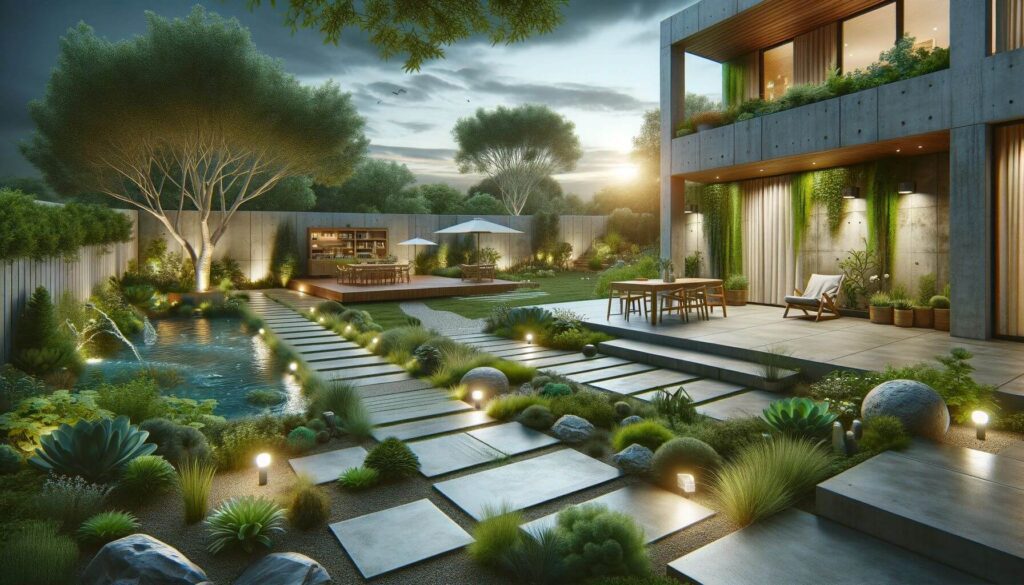
Concrete, while often criticized for its energy-intensive production process, offers opportunities for eco-friendly adaptation. Using recycled concrete or incorporating supplementary cementitious materials like fly ash can significantly reduce the patio’s environmental impact.
Permeable concrete options also contribute to sustainable landscaping by allowing water to seep through the surface, reducing runoff and promoting groundwater recharge. For those concerned about concrete’s longevity and recyclability, modern concrete mixes are designed to be both durable and potentially recyclable at the end of their lifecycle.
Professional Installation vs. DIY: Ensuring Quality and Safety
The allure of DIY projects is strong, offering personal satisfaction and potential cost savings. However, the complexity of installing wood deck versus concrete patio varies, influencing the feasibility and advisability of undertaking these projects without professional assistance.
DIY Projects: Weighing the Pros and Cons
- Wood Decks: DIY installation of a wood deck can be achievable for those with moderate construction skills, especially for simpler designs. However, understanding structural integrity, proper material selection, and local building codes is crucial. Mistakes in installation can lead to safety hazards and diminish the deck’s longevity and value.
- Concrete Patios: Pouring a concrete patio might seem straightforward, but achieving a level surface, proper curing, and desired finishes often requires expertise. DIY concrete projects carry the risk of cracking, unevenness, and drainage issues, which can compromise the patio’s functionality and aesthetic appeal.
Value of Professional Installation: Concrete Patio or Wood Deck
Engaging professionals for the installation of wood decks or concrete patios offers several advantages:
- Expertise: Professionals bring a wealth of experience, ensuring that the outdoor living space is constructed correctly, aesthetically pleasing, and compliant with local regulations.
- Safety: Professional installers are knowledgeable about the necessary safety standards, reducing the risk of accidents and structural failures.
- Longevity: Proper installation techniques extend the lifespan of the outdoor space, making it a more sustainable and cost-effective investment in the long run.
While DIY projects can be rewarding, the complexity of building a durable and safe outdoor living area often necessitates the skills and knowledge of a professional. Whether opting for a wooden deck or a concrete patio, prioritizing quality installation and sustainable practices ensures that the space will be enjoyed for years to come while minimizing its environmental impact.
Case Studies and Real-Life Examples
Case Study 1: Embracing the Warmth of a Wood Deck
The Johnson Family: Located in the Pacific Northwest, the Johnsons desired an outdoor space that blended with their home’s rustic aesthetic and the natural wooded landscape. They chose a cedar wood deck for its natural resistance to the region’s damp climate and its aesthetic harmony with the surroundings. The decision-making process involved consulting with a local deck builder who specialized in sustainable wood sourcing.
Post-installation, the family expressed high satisfaction, noting the deck’s warmth underfoot during cooler months and its seamless integration into the natural setting. Regular maintenance was a commitment they were willing to make, valuing the natural beauty and traditional appeal of wood.
Case Study 2: Opting for the Sleek Durability of a Concrete Patio
The Rivera Household: In a suburban area of Southern California, the Riveras wanted a low-maintenance, versatile outdoor space suitable for entertaining. They decided on a stamped concrete patio, drawn to its durability and the ability to mimic higher-end materials like natural stone.
The key factors in their decision included the patio’s resistance to the hot, dry climate and the minimal upkeep required. After completion, the Riveras were thrilled with the outcome, highlighting the ease of hosting gatherings and the added value to their home. The concrete patio’s durability and aesthetic versatility exceeded their expectations, making it a cherished part of their home.
How To Choose between Concrete Patio vs. Wood Deck
Navigating the choice between a wood deck and a concrete patio involves more than just comparing aesthetics, it’s about aligning with your lifestyle, maintenance willingness, and budget. The warmth and natural beauty of wood decks offer a traditional charm that resonates with many homeowners, albeit with a commitment to regular upkeep. In contrast, concrete patios provide a durable, versatile option with lower maintenance, appealing to those seeking a modern look or a more hands-off approach to outdoor living.
As illustrated by the Johnson and Rivera families, the decision significantly impacts satisfaction and lifestyle compatibility. Thus, it’s essential to weigh the pros and cons of each option, considering factors such as climate, intended use, and aesthetic preferences. Consulting with professionals can also provide valuable insights tailored to your specific situation.
FAQs Wood Deck vs. Concrete Patio: Choosing the Best Outdoor Living
Q: How do weather conditions affect the choice between wood and concrete? A: Weather plays a crucial role; wood may be preferable in cooler, milder climates, while concrete can be more suited to areas with high heat or fluctuating temperatures, considering its durability and maintenance requirements.
Q: Can both options be customized to fit any design style? A: Yes, both wood decks and concrete patios offer extensive customization options. Wood can be stained or painted to match your style, while concrete can be stamped, colored, or finished in various textures.
Q: What are the long-term costs associated with each option? A: Initial costs aside, wood decks typically require more frequent maintenance, which can add up over time. Concrete patios, known for their durability, offer savings in the long term due to minimal upkeep.
Q: How do I decide which option is best for my home? A: Consider factors like your climate, the desired aesthetic, maintenance commitment, and how you plan to use the space. Consulting with a landscape architect or contractor can also help tailor the decision to your specific needs and preferences.
Q: What is cheaper wood deck or concrete patio? A: Generally, a concrete patio is cheaper to install than a wood deck. Concrete costs about $6 to $10 per square foot installed, while a wood deck can range from $15 to $35 per square foot installed depending on the type of wood used. Therefore, concrete patios often provide a more economical choice with lower initial installation costs.
Choosing between a wood deck and a concrete patio is a significant decision that affects your home’s functionality, aesthetics, and value. By carefully considering your needs, lifestyle, and budget, you can select an option that enhances your outdoor living experience for years to come.



